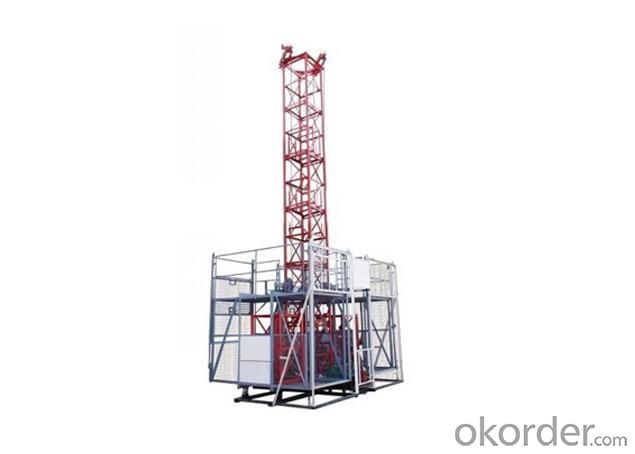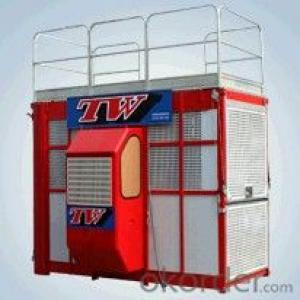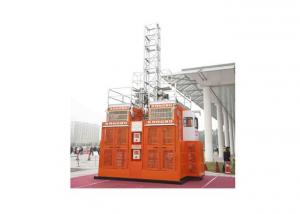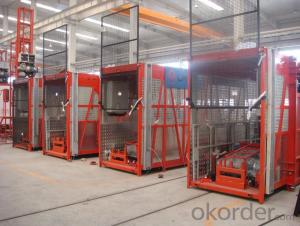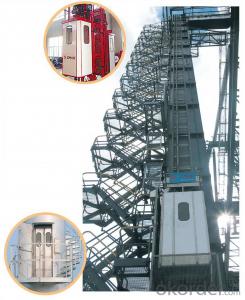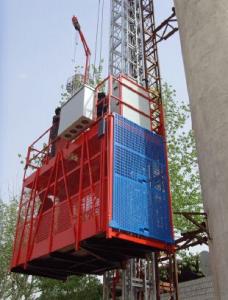BJ Material Hoist/Building Hoist
- Loading Port:
- China Main Port
- Payment Terms:
- TT or LC
- Min Order Qty:
- 1 Set set
- Supply Capability:
- 100 Sets per Week set/month
OKorder Service Pledge
OKorder Financial Service
You Might Also Like
Brief Introduction of Bj Material Hoist/building Hoist
The SS100,SS100/100 material hoist is a verical lifting machinery specialized materials,it’s widely used at building construction, industrial and mining enterprises, multilayer workplace,warehouse,station, ports and so on. It’s convenient, economical, efficient, safe, stable.
This type of material hoist is armed a series of safety protection device,like lifting weight limiter, safe protection device against rope
break ,parking device,cushioning device upper and lower height limiter and so on.Especially the safe protection device against rope break is designed by renowned professors in this industry grounded on a comprehensive analysis of the advantages and disadvantages of the current protection device. The maximum braking distance can reach far below 200mm, the standard of DBJ14-015-2002. In actual test, the drop distance reached as low as 70mm, without damaging the track. Thus, our product is very safe and reliable.
This machine is also equiped with complete GPS which automated and simplifized floor-selection and leveling, which reduces difficulty and
therange of manipulation, while promotes the accuracy of floor-selection, and thus, it improves the working efficiency, because traditionally,
this system was operated by hand or vehicle. This machine is ropeless. instead, it is attached to the wall, and has its own device of set-up and removal (mast and hand winch), easy for dismounting and transportation.
This machinery have two type,one is single cage,other is double cage. Mast section tube of the double cage is seamless steel tube Φ76×4.In the mast section tube of the single cage ,two of them is seamless steel tubeΦ76×4,the other two is Φ51×4.
Model | SS100/100 | SS100 |
Maximum height of lift(m) | 80(Enhanced type can reach 130m) | 80(Enhanced type can reach 130m) |
Standard height(m) | 24 | 24 |
Max lift weight(kg) | 1000/1000 | 1000 |
Rated speed(m/min) | 23.5 | 23.5 |
Cage demension(m) | 2.8×1.5×1.9 | 2.8×1.5×1.9 |
Mast section demension(m | 0.8×0.8×1.5 | 0.8×0.8×1.5 |
Working temperature | -20~40 | -20~40 |
Motor power(kw) | 15 | 7.5 |
Seamless tube dimeter(mm) | Φ76×4 | TWO Φ76×4
TWO Φ51×4 |
Whole machinery weight(24m) | 4350 | 3340 |
- Q: Describe the routine maintenance and inspection procedures for a building hoist.
- <p>The maintenance and inspection process for a building hoist involves several key steps to ensure safety and functionality. Regular visual inspections should be conducted to check for any visible damage or wear. Monthly inspections should include testing the emergency stop and limit switches, as well as lubricating moving parts. Quarterly inspections may involve checking the electrical connections and verifying the correct operation of safety devices. Annual inspections typically require a thorough examination by a qualified person, including testing the load-bearing capacity and ensuring all safety features are in good working order. Additionally, records of all inspections and maintenance should be kept for reference and compliance with safety regulations.</p>
- Q: How to save the elevator accident
- Expert clew Do not take an elevator with no safety check mark. The elevator person is safe to protect the condition, the passenger has no life danger, after the alarm, the patient wait for the person to help. When emergency situations such as earthquake, fire and elevator water are taken, the use of an elevator should not be used and the emergency passage or staircase should be used instead.
- Q: This question asks for a comparison between manual and automatic lifting systems used in construction equipment, highlighting their distinct features and operational differences.
- <p>Manual lifting systems in construction equipment rely on human effort to lift and move materials. They are often less expensive, require less maintenance, and are suitable for lighter loads or smaller-scale projects. However, they are labor-intensive, can be slower, and pose higher risks of injury due to the physical demands. Automatic lifting systems, on the other hand, use mechanical or electronic means to lift and move materials. They are more efficient, can handle heavier loads, and reduce the risk of injury by minimizing manual handling. These systems are often more expensive and require regular maintenance but offer precision, speed, and ease of operation, making them ideal for large-scale construction projects.</p>
- Q: Explain the benefits and drawbacks of using an electric winch compared to a building hoist.
- <p>Advantages of using an electric winch include ease of operation, lower noise levels, and the ability to be used in various environments. They are also more portable and can be easily moved between different locations. Disadvantages include higher initial costs compared to some building hoists, potential electrical hazards, and the need for regular maintenance to ensure safety. Additionally, electric winches may have lower lifting capacities compared to some building hoists, which could be a limitation for heavy construction tasks.</p>
- Q: This question asks for the proper steps to install a building hoist, a device used in construction to lift materials and workers.
- <p>To install a building hoist correctly, follow these steps: 1) Ensure the site is suitable and inspect the hoist for any damages. 2) Assemble the hoist tower on a solid, level base. 3) Install the mast and guide rails according to the manufacturer's instructions. 4) Attach the hoist mechanism and cab, ensuring all connections are secure. 5) Conduct a thorough inspection and test the hoist's functionality. 6) Obtain necessary permits and inspections from local authorities. 7) Train operators on the safe use of the hoist. Always adhere to safety guidelines and manufacturer's specifications.</p>
- Q: What is the main function of elevator motherboard?
- A control system includes light, machine, electric, calculate, calculate the mainboard is mainly responsible for, the equivalent of the human brain, it gathers the elevator running status, corresponding analog signal output, control of elevator running properly and safely.
- Q: Is it permissible to use a building hoist for lifting people or animals?
- <p>No, building hoists are not designed for lifting people or animals. They are specifically engineered for the transportation of materials and construction equipment. Using a building hoist for this purpose is dangerous and can lead to accidents. It is essential to adhere to safety regulations and use appropriate equipment for lifting people or animals to ensure their safety and comply with legal standards.</p>
- Q: How does the construction elevator add up
- You can use a ready-made high-altitude operating platform and a high-altitude working platform
- Q: Is it possible to replace an electric motor with a hydraulic cylinder in an electric-hydraulic lifting system?
- <p>No, a hydraulic cylinder cannot be used in place of a motor in an electric-hydraulic lifting system. A hydraulic cylinder is a component that converts hydraulic pressure into linear motion, while an electric motor converts electrical energy into mechanical energy. In an electric-hydraulic system, the motor drives a hydraulic pump, which generates the pressure needed to actuate the cylinder. The motor is essential for providing the power source, and the cylinder is the actuator that uses this power to perform work. Replacing the motor with a cylinder would result in a system without a power source, rendering it inoperative.</p>
- Q: This question asks for a description of the process of using a hydraulic cylinder in the context of a building hoist.
- <p>To use a hydraulic cylinder in a building hoist, first ensure the hoist is properly installed and secured. Connect the hydraulic cylinder to the hoist's power source, typically a hydraulic pump. The pump pressurizes hydraulic fluid, which is then directed into the cylinder. As the fluid enters, it pushes a piston within the cylinder, causing it to extend and lift the load. To lower the load, the fluid is released from the cylinder, allowing the piston to retract. Always monitor the pressure and ensure the system is leak-free for safe operation. Regular maintenance, including checking seals and lubricating parts, is crucial to prolong the life of the hydraulic cylinder and ensure efficient hoist performance.</p>
1. Manufacturer Overview
| Location | Beijing,China |
| Year Established | 2003 |
| Annual Output Value | |
| Main Markets | 15.00% Eastern Europe 15.00% South America 10.00% Mid East 10.00% Western Europe 10.00% North America 5.00% Oceania 5.00% Eastern Asia 5.00% Central America 5.00% Southeast Asia 5.00% Northern Europe 5.00% Southern Europe 5.00% South Asia 5.00% Africa |
| Company Certifications | ISO9001:2000;CE |
2. Manufacturer Certificates
| a) Certification Name | |
| Range | |
| Reference | |
| Validity Period |
3. Manufacturer Capability
| a) Trade Capacity | |
| Nearest Port | 11-20 People |
| Export Percentage | 21% - 30% |
| No.of Employees in Trade Department | |
| Language Spoken: | |
| b) Factory Information | |
| Factory Size: | 10,000-30,000 square meters |
| No. of Production Lines | 5 |
| Contract Manufacturing | |
| Product Price Range | |
Send your message to us
BJ Material Hoist/Building Hoist
- Loading Port:
- China Main Port
- Payment Terms:
- TT or LC
- Min Order Qty:
- 1 Set set
- Supply Capability:
- 100 Sets per Week set/month
OKorder Service Pledge
OKorder Financial Service
Similar products
Hot products
Hot Searches
Related keywords

